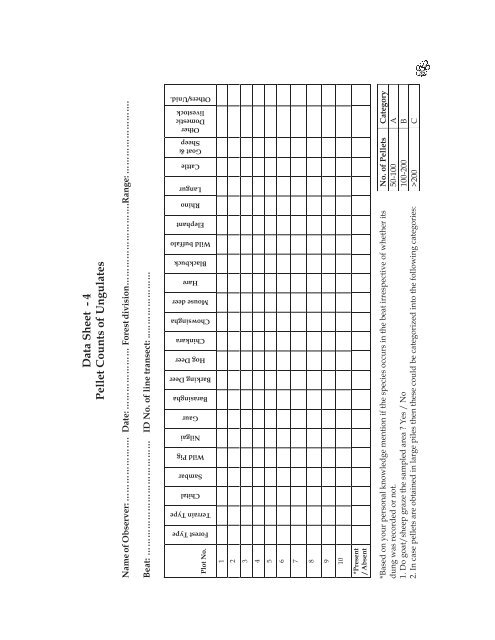FIELD GUIDE Monitoring Tigers, Co-Predators, Prey and their Habitats
FIELD GUIDE Monitoring Tigers, Co-Predators, Prey and their Habitats
FIELD GUIDE Monitoring Tigers, Co-Predators, Prey and their Habitats
Create successful ePaper yourself
Turn your PDF publications into a flip-book with our unique Google optimized e-Paper software.
35<br />
Data Sheet - 4<br />
Pellet <strong>Co</strong>unts of Ungulates<br />
Name of Observer: …………………. Date: ………………… Forest division……………………….Range: …………………….<br />
Beat: ………………………………… ID No. of line transect: ..…………………<br />
Forest Type<br />
Terrain Type<br />
Chital<br />
Sambar<br />
Wild Pig<br />
Nilgai<br />
Gaur<br />
Barasingha<br />
Barking Deer<br />
Hog Deer<br />
Chinkara<br />
Chowsingha<br />
Mouse deer<br />
Hare<br />
Blackbuck<br />
Wild buffalo<br />
Elephant<br />
Rhino<br />
Langur<br />
Cattle<br />
Goat &<br />
Sheep<br />
Other<br />
Domestic<br />
livestock<br />
Others/Unid.<br />
Plot No.<br />
1<br />
2<br />
3<br />
4<br />
5<br />
6<br />
7<br />
8<br />
9<br />
10<br />
*Present<br />
/ Absent<br />
*Based on your personal knowledge mention if the species occurs in the beat irrespective of whether its<br />
dung was recorded or not.<br />
1. Do goat/sheep graze the sampled area Yes / No<br />
2. In case pellets are obtained in large piles then these could be categorized into the following categories:<br />
No. of Pellets Category<br />
50-100 A<br />
100-200 B<br />
>200 C

















